A two-colour additive process invented by Anthony Bernardi in the United Kingdom.
Film Explorer
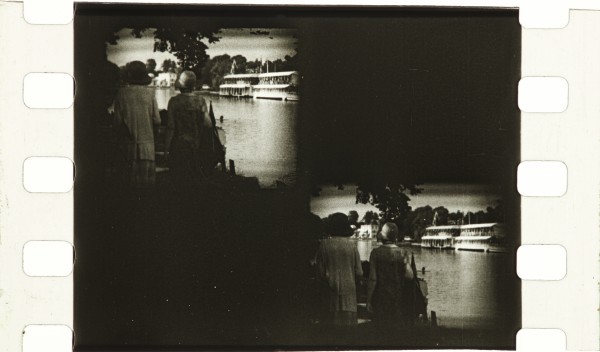
Unidentified film, c. 1930–32. This is an example of the first version of Raycol, with images in a distinctive diagonal arrangement. Two quarter-size images were produced via a rhomboidal prism installed in the camera behind the lens. The prism split the light entering the camera and directed it through red and green filters to the different corners of a standard 35mm film frame. Later versions of Raycol used a twin-lens camera to record images vertically aligned.
National Science and Media Museum, Bradford, United Kingdom. Photograph by Barbara Flueckiger in collaboration with Noemi Daugaard. Timeline of Historical Film Colors. https://filmcolors.org/timeline-entry/1244/#/image/14689.
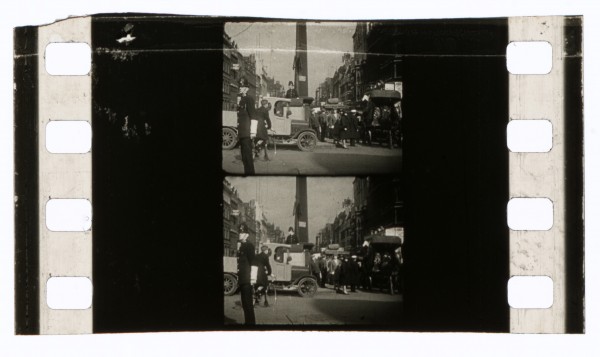
Unidentified film, c. 1931–35. Later versions of Raycol used a twin-lens camera to produce two quarter-sized pictures, one placed directly above the other, in the normal frame area. The images were projected through two half-lenses, which could be adjusted to ensure that the correct superimposition of the two images was achieved on the screen. Initially, upon projection, the images were superimposed, one through a red filter and one through no filter. The system was later developed to use coloured lenses – one with red-orange glass and one with green glass.
Film Frame Collection, Seaver Center for Western History Research, Natural History Museum of Los Angeles County, Los Angeles, CA, United States.
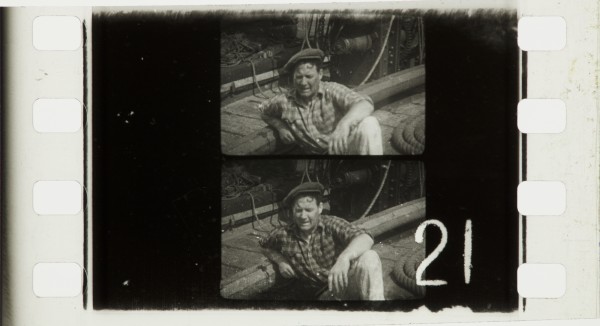
The Skipper of the Osprey (1933). “An improved version of Raycol, 1933, placed the two-colour records one above the other. To project the film, an ordinary projector was used, with the lens replaced by a special Raycol lens. The Raycol lens consisted of two D-shaped half lenses, one fitted with a red filter, and the other with no filter at all. The result of superimposing a red picture upon a black and white one might have been expected to produce only a washed-out reddish coloured image, but in fact a subjective impression of quite a wide range of colours was produced, albeit somewhat pale.” (Coe, 1981)
National Science and Media Museum, Bradford, United Kingdom. Photograph by Barbara Flueckiger in collaboration with Noemi Daugaard. Timeline of Historical Film Colors. https://filmcolors.org/galleries/raycol-samples-kodak-film-samples-collection/
Identification
Unknown
B/W
Some surviving examples have British Eastman Kodak edge markings.
1
The color appeared during projection, through the use of red-orange and green glass lenses.
Unknown
At least some Raycol productions were released with sound, but it is unclear what sound format was used.
Approximately 11.02mm x 8.93mm (0.434 in x 0.352 in) for initial diagonal orientation. Approximately 11.95mm x 8.24mm (0.470 in x 0.324 in) for the later vertical orientation.
B/W, panchromatic.
Unknown
History
Raycol was the invention of the Austrian chemist Anton Bernardi. Bernardi moved to Britain in 1926, changing his name to Anthony Bernardi, to raise capital for the development of his new colour process. His initial attempts failed, resulting in him being adjudged bankrupt in 1928. The judgment was, however, reversed because Bernardi patented his process in February 1928 and while in the bankruptcy courts he sold the rights to Charles Bolton, director of the mining company Wheal Reeth Tin Ltd, who formed a company, Raycol Ltd, to acquire them. Raycol Ltd was quickly wound up and Bernardi and Bolton formed a holding company, Temple Holdings Ltd, to prepare for the formation in 1929 of Raycol British Corporation Ltd. Bernardi was hired as technical advisor, while on the board sat Bolton, along with Charles Henry, the Duke of Richmond and Gordon, Major John Sewell Courtauld MP and the film-maker Maurice Elvey, who was also managing director of the company. With such heavyweight personalities on the board, Raycol was clearly aiming at a big success. In 1929 author Elinor Glyn announced she was producing a sound version of one of her novels, Knowing Men, and Elvey offered on behalf of Raycol to bankroll the production if she made it using the process. The deal quickly fell through and Glyn instead used the Talkicolor process, but the offer to fund the production indicates the ambition of Raycol British. Elvey demonstrated the process to the trade in July 1930 and in September announced that six shorts and seven features would go into production early in 1931. However, the only film made was the short The School for Scandal, directed by Elvey in 1930, which has the distinction of being the first British colour sound film. Bernardi moved on in 1930 to work on the development of Talkicolor. Over the next three years Raycol was used for shorts and animated films before production of the first Raycol feature film, The Skipper of the Osprey (1933).
In December 1933 a new company, Raycol British Productions Ltd, was formed and granted sole and exclusive rights to the Raycol process, but nothing came of the venture. Elvey and Bolton ceased to be involved, and in 1935 Raycol’s development continued under Basil Dean’s Associated Talking Pictures (ATP). This deal was negotiated by Jack and Stephen Courtald who were directors of both Raycol and ATP. ATP announced plans to transform Raycol from a two- to a three-colour process in July 1935, the same week that Becky Sharp was premiered. Dean announced plans in September to use Raycol to film colour versions of Twelfth Night and The Tempest. However, nothing came of these plans.
Raycol British and Raycol British Productions were both wound up. In 1934 Bernardi took on the directorship and development of Omnicolor.
[Reprinted from Brown, Simon (2012). “Technical Appendix”, pp. 280–281. In Sarah Street (ed.), Color Films in Britain: The Negotiation of Innovation 1900–55. Basingstoke: Palgrave Macmillan with permission from Bloomsbury Publishing.]
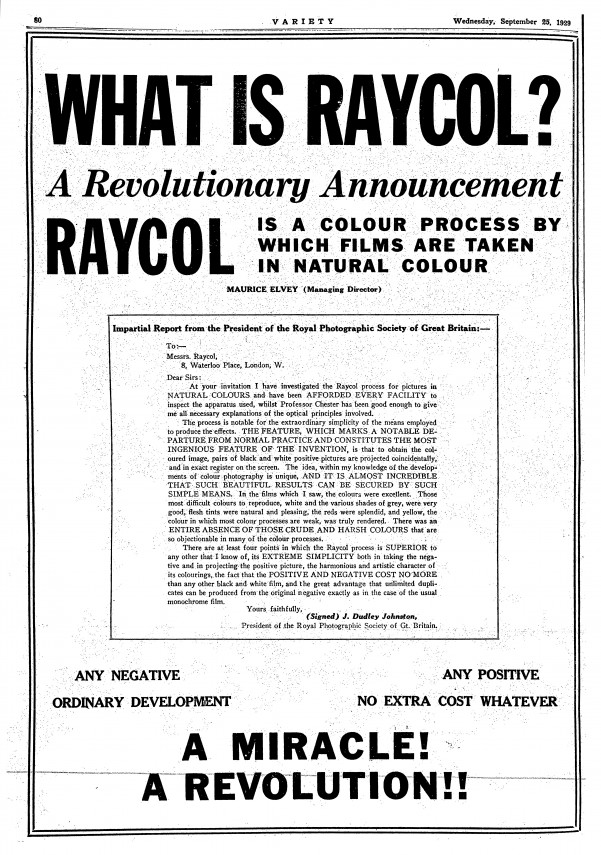
A trade advertisement for Raycol used the President of Royal Photographic Society John Dudley Johnston’s endorsement, which mentioned Raycol as a “superior” process and “unique” idea in the development of colour photography that provided “beautiful colours”.
Anon. (1929). “What is Raycol?”. Variety, September 25, 1929: p. 80.
Selected Filmography
An example of a short, animated film shot using Raycol. Like all other Raycol animations, it is considered lost. Adrian Bernard Klein (aka Adrian Cornwell-Clyne), the director of the film, later published books on the history of motion picture colour processes and was also involved in the development of both Dufaycolor and Gasparcolor in the UK.
An example of a short, animated film shot using Raycol. Like all other Raycol animations, it is considered lost. Adrian Bernard Klein (aka Adrian Cornwell-Clyne), the director of the film, later published books on the history of motion picture colour processes and was also involved in the development of both Dufaycolor and Gasparcolor in the UK.
An animated short.
An animated short.
One of the first British colour sound films, the only feature-length film shot using Raycol. It is considered lost.
One of the first British colour sound films, the only feature-length film shot using Raycol. It is considered lost.
The film used an improved version of Raycol where the two colour-separation frames were recorded not diagonally, but one above the other.
The film used an improved version of Raycol where the two colour-separation frames were recorded not diagonally, but one above the other.
Animated short released under the subtitle Barnacle Bill No 1. It was intended as the first of a series, but no further films were produced.
Animated short released under the subtitle Barnacle Bill No 1. It was intended as the first of a series, but no further films were produced.
Technology
Raycol used a beam splitter to produce two quarter-sized pictures in the normal frame area. At first the two images were diagonal in the frame, but later this was adjusted so that they were placed one directly above the other. The images were projected through two half-lenses one above the other, which could be adjusted to ensure that correct superimposition of the two images was achieved on the screen. Initially, upon projection the images were superimposed, one through a red filter and one through no filter, which made the picture brighter than normal and offered a surprising range of colours considering only one filter was used. This system was eventually replaced by using coloured lenses, one red-orange glass and one green glass.
Like most additive processes the drawback with Raycol was that it needed special projection equipment and very precise adjustment on the part of the projectionist, resulting in frequent problems at screenings of the film.
[Reprinted from Brown, Simon (2012). “Technical Appendix”, pp. 280–281. In Sarah Street (ed.), Color Films in Britain: The Negotiation of Innovation 1900–55. Basingstoke: Palgrave Macmillan with permission from Bloomsbury Publishing.]
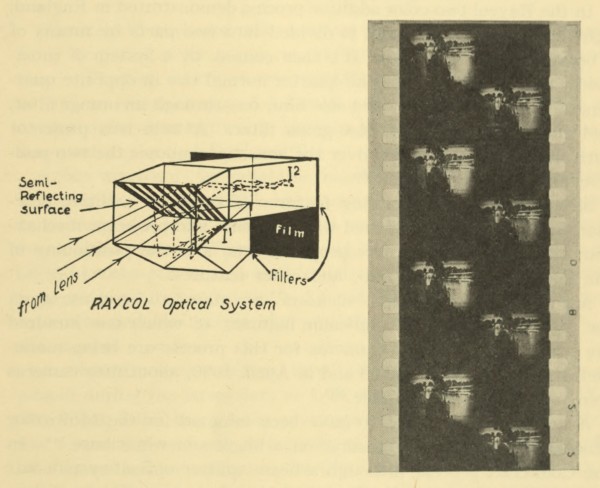
The beam-splitting optical system used in the camera behind the lens for the first iteration of the Raycol two-colour additive process (left); and a print showing the position of the two colour records positioned diagonally within the standard 35mm frame area.
“Progress in Motion Picture Industry”. Journal of the SMPE (July 1930): p. 107.

The twin-lens used to capture one colour record above the other, for the second iteration of Raycol, c. 1931.
Alldridge, Reginald Stratten. 1931. Cinematograph camera, US Patent 1,916,132, filed January 29, 1931, patented June 27, 1933.
References
Coe, Brian (1981). The History of Movie Photography. London: Ash & Grant: p. 120.
Cornwell-Clyne, Adrian (1951). Colour Cinematography (3rd edn). London: Chapman & Hall: pp. 265–268.
National Archives (1928). BT 31/33013/234772, Raycol Ltd. National Archives, Richmond, Surrey, United Kingdom.
National Archives (1929). BT 31/33090/239872, Raycol British Corporation Ltd. National Archives, Richmond, Surrey, United Kingdom.
National Archives (1933). BT 31/35591/282398, Raycol Productions Ltd. National Archives, Richmond, Surrey, United Kingdom.
Timeline of Historical Film Colors (n.d.). “Raycol”. https://filmcolors.org/timeline-entry/1244/
Williams, Rhys (n.d.). Rhys Williams Collection, (Rhys_Williams_J_16/2/1, 16/2/2, 16/2/3). London School of Economics British Library of Political and Economic Science, United Kingdom.
Patents
Groc, Edouard Lucien & Anthony Bernardi. 1928. Improvements relating to Colour Photography and Colour Cinematography, British Patent 312,248, filed February 20, 1928, patented May 21, 1929.
Alldridge, Reginald Stratten. 1928. Improvements in or relating to Photographic Cameras, British Patent 322,801, filed July 16, 1928, patented December 16, 1929.
Bernardi, Anthony for Raycol, Ltd. 1929. Improvements in or relating to the Projection of Pictures in Natural Colours, British Patent 329,438. 22, filed March 19, 1929, patented May 22, 1930.
Bernardi, Anthony for Raycol, Ltd. 1929. An Improved Method of Enabling Pictures or the like to be Exhibited in Substantially Natural Colours, British Patent 335,310, filed July 18, 1929, patented September 25, 1930.
Cheshire, Frederick John. 1929. [Title unknown], British Patent 335,038, patented August 30, 1929.
Alldridge, Reginald Stratten. 1931. Cinematograph camera, US Patent 1,916,1932, filed January 29, 1931, patented June 27, 1933.
Followed by
Compare
Related entries
Authors
Simon Brown is Associate Professor of Film and Television at Kingston University, London, UK. He has written extensively on many aspects of film history and technology – including early, silent and British cinema, 3D and colour cinematography. His publications include the monograph Cecil Hepworth and the Rise of the British Film Industry 1899–1911 (University of Exeter Press, 2016) a Technical Appendix on colour film processes in Colour Films in Britain: The Negotiation of Innovation 1900–1955 by Sarah Street (BFI Publishing, 2012) and the online article “Dufaycolor: The Spectacle of Reality and British National Cinema” (2002) – available at http://www.bftv.ac.uk/projects/dufaycolor.htm.
Oleksandr Teliuk is a film scholar, archivist and artist. As a film archivist and programmer, he worked at the Dovzhenko Center, Ukrainian State Film Archive. He was co-curator of film programmes and exhibitions at the Film Museum of Dovzhenko Center, including “VUFKU: Lost & Found” (2019); co-editor of books (Cinematographic Revision of Donbas [2017, 2018], Chornobyl (In)Visible [2017] and Ukrainian Film Critic Anthology of the 1920s [2018—2022]); curator of numerous film programmes of Ukrainian archival cinema at international film festivals. He is a graduate of the L. Jeffrey Selznick School of Film Preservation (2024).
The History, Technology and References sections are written by Simon Brown using text reprinted from the Technical Appendix of Colour Films in Britain: The Negotiation of Innovation 1900–55 (2012). All other text was written, or compiled, by Oleksandr Teliuk.
Brown, Simon & Oleksandr Teliuk (2024). “Raycol”. In James Layton (ed.), Film Atlas. www.filmatlas.com. Brussels: International Federation of Film Archives / Rochester, NY: George Eastman Museum.


